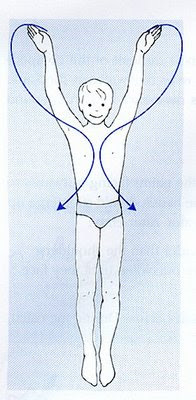Hold on to your hats I'm now going to give you some real technical information. But keep reading because at the end the information will stand you in good stead, ready for when I give you the drill. Now that we have the Butterfly Leg Action or Dolphin Kick going, it's time to look at the Butterfly Arm Action.
widget
Hold on to your hats I'm now going to give you some real technical information. But keep reading because at the end the information will stand you in good stead, ready for when I give you the drill. Now that we have the Butterfly Leg Action or Dolphin Kick going, it's time to look at the Butterfly Arm Action.
Because both of your arms go out and over the water at the same time.
The stroke itself is broken into several stages:
The In Sweep is the first of the two most propulsive phases of the stroke. During the In Sweep:
Your arms sweep downwards, inwards and then upwards in a semicircular movement until they are under the shoulders, close to the midline of the body
Your hands should be pitched to allow the water to be deflected backwards over the palms from your thumb to the little-finger side
Your hands should at this point speed up.
The Up Sweep, the second of the major propulsion phases, commences as your hands come close together under the middle of your body.
During the Up Sweep your hands change directions to a backwards, outwards and upwards movement until they come close to the surface beside your thighs.
The Up Sweep is usually the most powerful part of the stroke.
The release of the hands occurs just prior to the arms fully extending and before the hands reach the surface.
The release is made by turning the palms of your hands inwards to allow them to be slid out of the water with minimum resistance.
Your arms must be extended during the exit from the water to allow a
circling up, out and forward movement.
Now your arms and hands skim above the surface of the water until the entry is made.
During the over-water recovery, the palms of your hands should face inwards
during the first half and be rotated outwards during the second half. Your
head should be lowered with your chin pressed towards your neck.
So now that you know all the technical stuff it's time to figure out a way to learn in the arm action. So next time we'll talk about my butterfly drill.
Dropdown
Subject Search Bar
Amazon Link Only Ads
Learn How To Swim 101 - Butterfly - The Arm Movement
Hold on to your hats I'm now going to give you some real technical information. But keep reading because at the end the information will stand you in good stead, ready for when I give you the drill. Now that we have the Butterfly Leg Action or Dolphin Kick going, it's time to look at the Butterfly Arm Action.
Butterfly Arm Movement
Why is the butterfly stroke often considered to be the most difficult of the competitive strokes?Because both of your arms go out and over the water at the same time.
The stroke itself is broken into several stages:
- The Catch
- The In sweep
- The Up sweep
- The Recovery
Entry And Catch: Where Your Hands Enter The Water
Your hands enter the water shoulder width apart, with the palms facing outwards so your hands slide smoothly into the water. Your hands should submerge up to about 20 centimeters below the surface of the water and sweep outwards until they are wider than your shoulders (see second picture below). Your palms should slowly rotate in towards the end of the out sweep until they face back. |
| Butterfly Arm Entry |
 |
| Butterfly Stroke Underwater View |
The In and The Up Sweep
The In Sweep is the first of the two most propulsive phases of the stroke. During the In Sweep:
Your arms sweep downwards, inwards and then upwards in a semicircular movement until they are under the shoulders, close to the midline of the body
Your hands should be pitched to allow the water to be deflected backwards over the palms from your thumb to the little-finger side
Your hands should at this point speed up.
The Up Sweep, the second of the major propulsion phases, commences as your hands come close together under the middle of your body.
During the Up Sweep your hands change directions to a backwards, outwards and upwards movement until they come close to the surface beside your thighs.
The Up Sweep is usually the most powerful part of the stroke.
Arm Recovery
The release of the hands occurs just prior to the arms fully extending and before the hands reach the surface.
 |
| Butterfly Arms Exiting The Water |
The release is made by turning the palms of your hands inwards to allow them to be slid out of the water with minimum resistance.
Your arms must be extended during the exit from the water to allow a
circling up, out and forward movement.
Now your arms and hands skim above the surface of the water until the entry is made.
During the over-water recovery, the palms of your hands should face inwards
during the first half and be rotated outwards during the second half. Your
head should be lowered with your chin pressed towards your neck.
The Drill
So now that you know all the technical stuff it's time to figure out a way to learn in the arm action. So next time we'll talk about my butterfly drill.
Enjoy
Richard
Richard

No comments:
Post a Comment